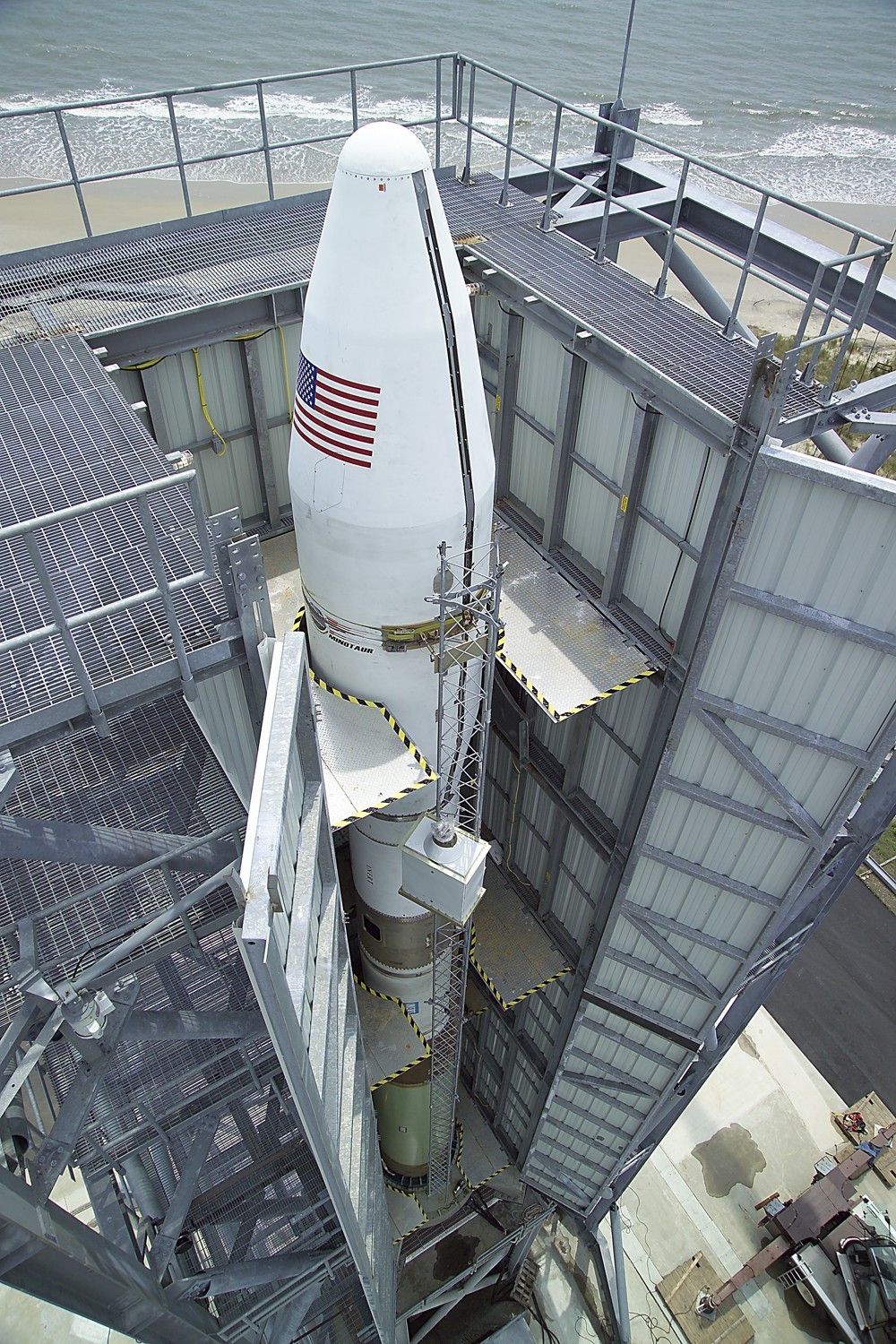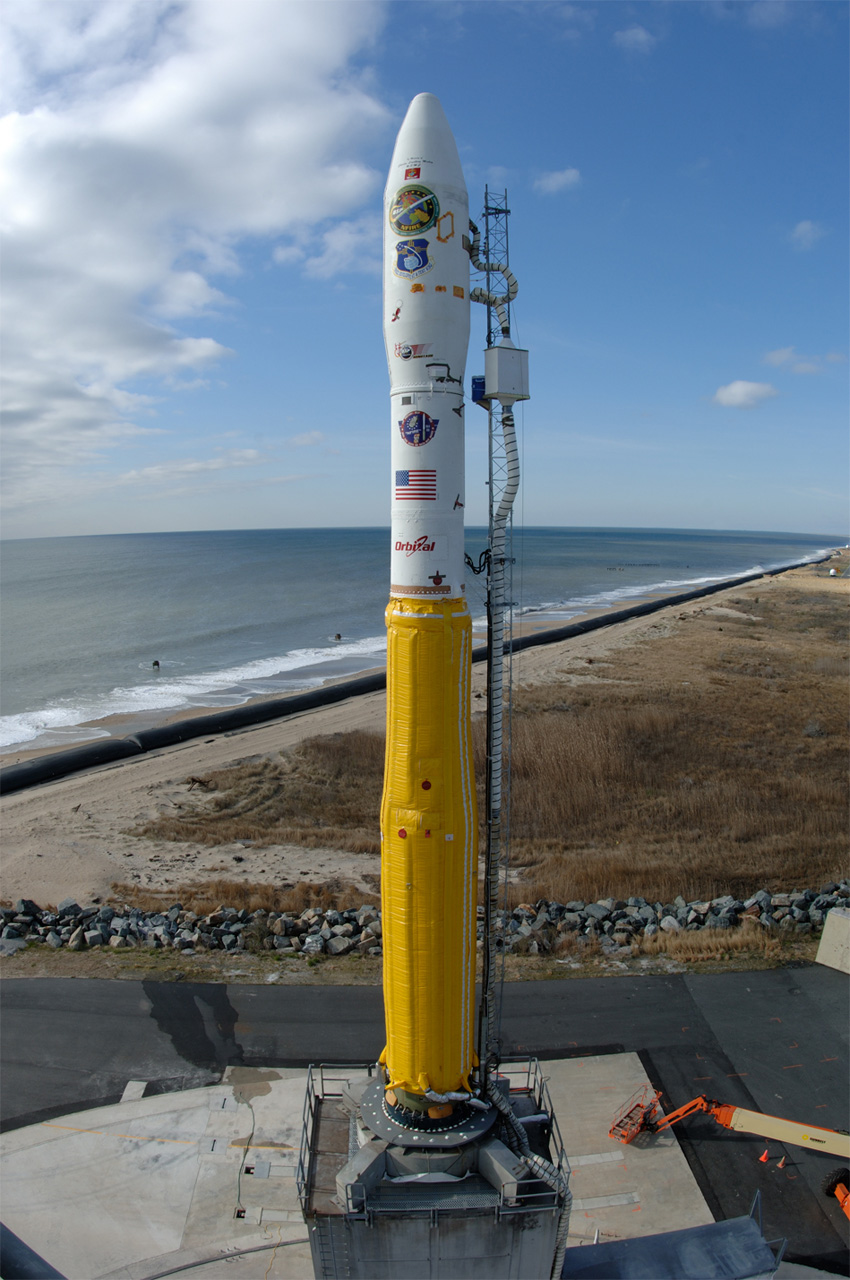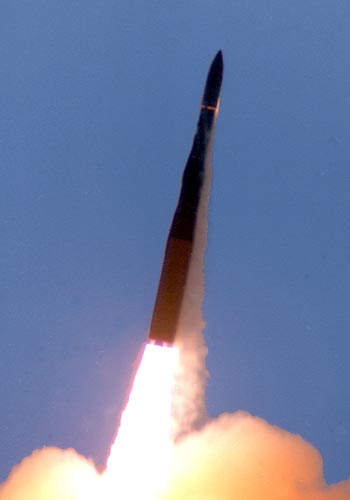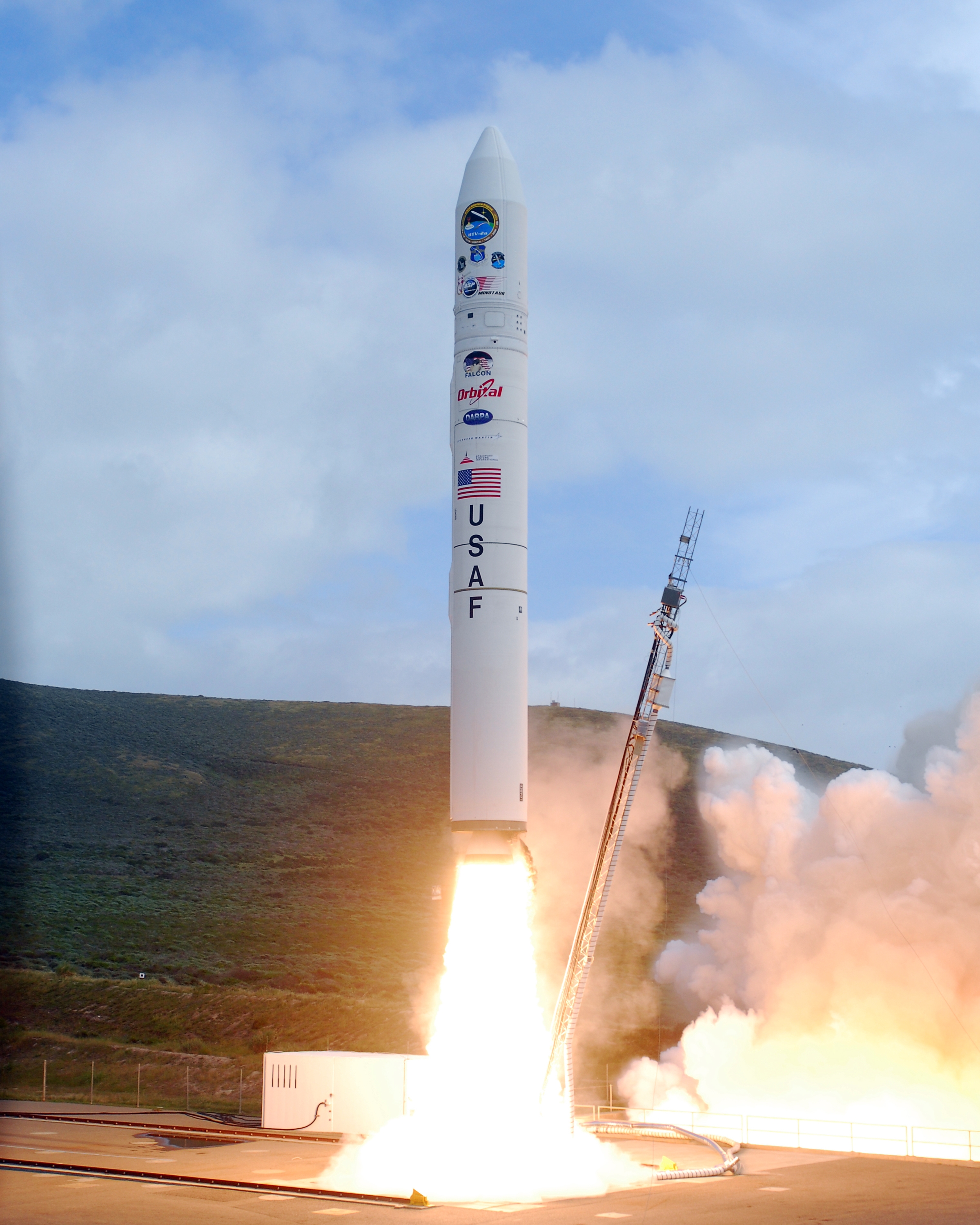Minotaur (rocket) on:
[Wikipedia]
[Google]
[Amazon]
 The Minotaur is a family of United States solid-fuel launch vehicles repurposed from retired Minuteman and Peacekeeper model
The Minotaur is a family of United States solid-fuel launch vehicles repurposed from retired Minuteman and Peacekeeper model
"Taurus rocket on the market with new name, upgrades"
Spaceflight Now 24 February 2014 Minotaur-C (for "Minotaur-Commercial"), was the first of the Minotaur vehicle family, and the first ground-launched orbital booster developed by
 The original Minotaur launch vehicle, consisting of an M55A1 first stage, SR19 second stage, Orion 50XL third stage, Orion 38 fourth stage, and optional HAPS fifth stage for velocity trim and multiple payload deployment. Payload 580 kg to a 185 km, 28.5° orbit from
The original Minotaur launch vehicle, consisting of an M55A1 first stage, SR19 second stage, Orion 50XL third stage, Orion 38 fourth stage, and optional HAPS fifth stage for velocity trim and multiple payload deployment. Payload 580 kg to a 185 km, 28.5° orbit from
 A suborbital target vehicle, consisting of an SR118 first stage, SR119 second stage, SR120 third stage, and Super HAPS fourth stage. Payload 3060 kg on a 6700 km suborbital trajectory. The vehicle's development was cancelled and the Minotaur III was never flown.
A suborbital target vehicle, consisting of an SR118 first stage, SR119 second stage, SR120 third stage, and Super HAPS fourth stage. Payload 3060 kg on a 6700 km suborbital trajectory. The vehicle's development was cancelled and the Minotaur III was never flown.
 The Minotaur IV combines U.S. government-furnished solid rocket motors from decommissioned Peacekeeper ICBMs with technologies from other Orbital-built launch vehicles, including the Minotaur I,
The Minotaur IV combines U.S. government-furnished solid rocket motors from decommissioned Peacekeeper ICBMs with technologies from other Orbital-built launch vehicles, including the Minotaur I,
 The Minotaur V is a five-stage version based on the Minotaur IV+. It has an additional upper stage for small geostationary transfer orbit (GTO), lunar, and interplanetary missions.
The Minotaur V is a five-stage version based on the Minotaur IV+. It has an additional upper stage for small geostationary transfer orbit (GTO), lunar, and interplanetary missions.
Minotaur I Rocket page
Minotaur IV Rocket page
*
{{US launch systems Northrop Grumman space launch vehicles Orbital Sciences Corporation space launch vehicles Expendable space launch systems
 The Minotaur is a family of United States solid-fuel launch vehicles repurposed from retired Minuteman and Peacekeeper model
The Minotaur is a family of United States solid-fuel launch vehicles repurposed from retired Minuteman and Peacekeeper model intercontinental ballistic missile
An intercontinental ballistic missile (ICBM) is a ballistic missile with a range (aeronautics), range greater than , primarily designed for nuclear weapons delivery (delivering one or more Thermonuclear weapon, thermonuclear warheads). Conven ...
s. Built by Northrop Grumman
Northrop Grumman Corporation is an American multinational Aerospace manufacturer, aerospace and Arms industry, defense company. With 97,000 employees and an annual revenue in excess of $40 billion, it is one of the world's largest Arms industry ...
under the Space Force's Rocket Systems Launch Program, these vehicles are used for various space and test launch missions.
The Minotaur family consists of four main variants: the Minotaur I
The Minotaur I, or just Minotaur is an American expendable launch system derived from the LGM-30 Minuteman, Minuteman II missile. It is used to launch Small satellite, small satellites for the Us government, US Government, and is a member of the M ...
, primarily used for launching small satellites into low Earth orbit; the Minotaur II, primarily used as a suborbital target vehicle; the Minotaur IV
Minotaur IV, also known as Peacekeeper SLV and OSP-2 PK is an active expendable launch system derived from the retired LGM-118 Peacekeeper ICBM. It is operated by Northrop Grumman Space Systems, and made its maiden flight on 22 April 2010 car ...
, a small-lift launch vehicle; and the Minotaur V
Minotaur V is an American expendable launch system derived from the Minotaur IV, itself a derivative of the retired LGM-118 Peacekeeper Intercontinental ballistic missile, ICBM. Minotaur V was developed by Orbital Sciences Corporation (now absorb ...
, capable of reaching higher orbits, including geostationary transfer orbit
In space mission design, a geostationary transfer orbit (GTO) or geosynchronous transfer orbit is a highly elliptical type of geocentric orbit, usually with a perigee as low as low Earth orbit (LEO) and an apogee as high as geostationary orbit ...
and trans-lunar trajectories. Minotaur I and II are derived from the Minuteman missile, while Minotaur IV, V, and the cancelled Minotaur III are based on the Peacekeeper ICBM.
Vehicles
Minotaur-C (Taurus)
The Taurus launch vehicle, later renamed Stephen Clark"Taurus rocket on the market with new name, upgrades"
Spaceflight Now 24 February 2014 Minotaur-C (for "Minotaur-Commercial"), was the first of the Minotaur vehicle family, and the first ground-launched orbital booster developed by
Orbital Sciences Corporation
Orbital Sciences Corporation (commonly referred to as Orbital) was an American company specializing in the design, manufacture, and launch of small- and medium- class space and launch vehicle systems for commercial, military and other governmen ...
(OSC), derived by adding a solid booster stage to the air-launched Pegasus
Pegasus (; ) is a winged horse in Greek mythology, usually depicted as a white stallion. He was sired by Poseidon, in his role as horse-god, and foaled by the Gorgon Medusa. Pegasus was the brother of Chrysaor, both born from Medusa's blood w ...
rocket.
The first flight, sponsored by DARPA
The Defense Advanced Research Projects Agency (DARPA) is a research and development agency of the United States Department of Defense responsible for the development of emerging technologies for use by the military. Originally known as the Adva ...
, was in 1994. After a series of failures between 2001 and 2011, the launch vehicle was rebranded as Minotaur-C in 2014. Due to laws against selling government equipment, the Minotaur-C is the only available Minotaur launch vehicle for commercial launches.
Minotaur I
 The original Minotaur launch vehicle, consisting of an M55A1 first stage, SR19 second stage, Orion 50XL third stage, Orion 38 fourth stage, and optional HAPS fifth stage for velocity trim and multiple payload deployment. Payload 580 kg to a 185 km, 28.5° orbit from
The original Minotaur launch vehicle, consisting of an M55A1 first stage, SR19 second stage, Orion 50XL third stage, Orion 38 fourth stage, and optional HAPS fifth stage for velocity trim and multiple payload deployment. Payload 580 kg to a 185 km, 28.5° orbit from Cape Canaveral
Cape Canaveral () is a cape (geography), cape in Brevard County, Florida, in the United States, near the center of the state's Atlantic Ocean, Atlantic coast. Officially Cape Kennedy from 1963 to 1973, it lies east of Merritt Island, separated ...
; or 310 kg to a 740 km Sun-synchronous orbit
A Sun-synchronous orbit (SSO), also called a heliosynchronous orbit, is a nearly polar orbit around a planet, in which the satellite passes over any given point of the planet's surface at the same local mean solar time. More technically, it is ...
(SSO) from Vandenberg.
Minotaur II
A suborbital target vehicle, essentially consisting of aMinuteman II
The LGM-30 Minuteman is an American land-based intercontinental ballistic missile (ICBM) in service with the Air Force Global Strike Command. , the LGM-30G (Version 3) is the only land-based ICBM in service in the United States and represents th ...
with Orbital guidance and control systems. Consists of M55A1 first stage, SR19 second stage, and M57 third stage. Payload 460 kg on 6700 km suborbital trajectory.
Minotaur III
 A suborbital target vehicle, consisting of an SR118 first stage, SR119 second stage, SR120 third stage, and Super HAPS fourth stage. Payload 3060 kg on a 6700 km suborbital trajectory. The vehicle's development was cancelled and the Minotaur III was never flown.
A suborbital target vehicle, consisting of an SR118 first stage, SR119 second stage, SR120 third stage, and Super HAPS fourth stage. Payload 3060 kg on a 6700 km suborbital trajectory. The vehicle's development was cancelled and the Minotaur III was never flown.
Minotaur IV
 The Minotaur IV combines U.S. government-furnished solid rocket motors from decommissioned Peacekeeper ICBMs with technologies from other Orbital-built launch vehicles, including the Minotaur I,
The Minotaur IV combines U.S. government-furnished solid rocket motors from decommissioned Peacekeeper ICBMs with technologies from other Orbital-built launch vehicles, including the Minotaur I, Pegasus
Pegasus (; ) is a winged horse in Greek mythology, usually depicted as a white stallion. He was sired by Poseidon, in his role as horse-god, and foaled by the Gorgon Medusa. Pegasus was the brother of Chrysaor, both born from Medusa's blood w ...
, and Taurus
Taurus is Latin for 'bull' and may refer to:
* Taurus (astrology), the astrological sign
** Vṛṣabha, in vedic astrology
* Taurus (constellation), one of the constellations of the zodiac
* Taurus (mythology), one of two Greek mythological ch ...
. The Minotaur IV launch vehicle consists of an SR118 first stage, SR119 second stage, SR120 third stage, and Orion 38 fourth stage. Payload 1735 kg to a 185 km, 28.5° orbit from Cape Canaveral.
The first Minotaur IV was launched 22 April 2010 from Vandenberg Air Force Base in California
California () is a U.S. state, state in the Western United States that lies on the West Coast of the United States, Pacific Coast. It borders Oregon to the north, Nevada and Arizona to the east, and shares Mexico–United States border, an ...
. This vehicle is also being developed to accommodate the Conventional Prompt Global Strike (CPGS) mission for the Air Force.
Minotaur V
 The Minotaur V is a five-stage version based on the Minotaur IV+. It has an additional upper stage for small geostationary transfer orbit (GTO), lunar, and interplanetary missions.
The Minotaur V is a five-stage version based on the Minotaur IV+. It has an additional upper stage for small geostationary transfer orbit (GTO), lunar, and interplanetary missions.
NASA
The National Aeronautics and Space Administration (NASA ) is an independent agencies of the United States government, independent agency of the federal government of the United States, US federal government responsible for the United States ...
's Lunar Atmosphere and Dust Environment Explorer
The Lunar Atmosphere and Dust Environment Explorer (LADEE; ) was a NASA lunar exploration and technology demonstration mission. It was launched on a Minotaur V rocket from the Mid-Atlantic Regional Spaceport on September 7, 2013. During its seve ...
(LADEE) mission was launched on the first Minotaur V, from the Wallops Island
Wallops Island is a island in Accomack County, Virginia, part of the Virginia Barrier Islands that stretch along the eastern seaboard of the United States. It is just south of Chincoteague Island, a popular tourist destination.
Wallops Isla ...
, Virginia
Virginia, officially the Commonwealth of Virginia, is a U.S. state, state in the Southeastern United States, Southeastern and Mid-Atlantic (United States), Mid-Atlantic regions of the United States between the East Coast of the United States ...
launch site at 03:27 UTC on 7 September 2013. The Minotaur launched the LADEE spacecraft into a highly elliptic orbit where it can phase and time its trajectory burn to the moon.
Minotaur VI
The Minotaur VI is a five-stage launch vehicle proposed by Northrop Grumman that, as of 2025, has not flown. Minotaur VI is based on the Minotaur IV+, adding a second SR-118 first stage to increase performance. A further enhanced variant, Minotaur VI+, is also proposed for beyond low Earth orbit missions using an added Star 37FM sixth stage motor. For example, Minotaur VI+ can send up to of payload to Mars.Launch statistics
Rocket configurations
Launch sites
Launch outcomes
Launch history
Planned launches
See also
* Dnepr, a converted Soviet ICBM often used for commercial satellite launches * Modified Minotaur IV (Ascent Abort-2), Ascent Abort-2 (AA-2), was a suborbital flight to test the Launch Abort System (LAS) of NASA'sOrion spacecraft
Orion (Orion Multi-Purpose Crew Vehicle or Orion MPCV) is a partially reusable crewed spacecraft used in NASA's Artemis program. The spacecraft consists of a Crew Module (CM) space capsule designed by Lockheed Martin that is paired with a Eu ...
. The suborbital flight used a modified Minotaur IV, launched 2 July 2019, at 11:00 UTC from CCAFS SLC-46. The suborbital flight was a success.
References
External links
Minotaur I Rocket page
Minotaur IV Rocket page
*
{{US launch systems Northrop Grumman space launch vehicles Orbital Sciences Corporation space launch vehicles Expendable space launch systems
Minotaur
In Greek mythology, the Minotaur (, ''Mīnṓtauros''), also known as Asterion, is a mythical creature portrayed during classical antiquity with the head and tail of a bull and the body of a man or, as described by Roman poet Ovid, a being "par ...
Rocket families
Solid-fuel rockets